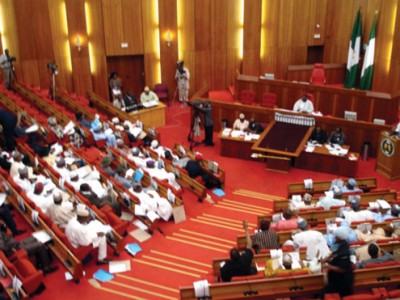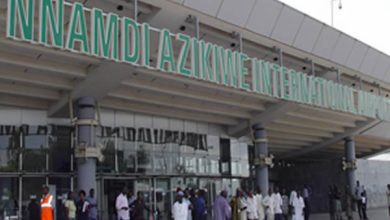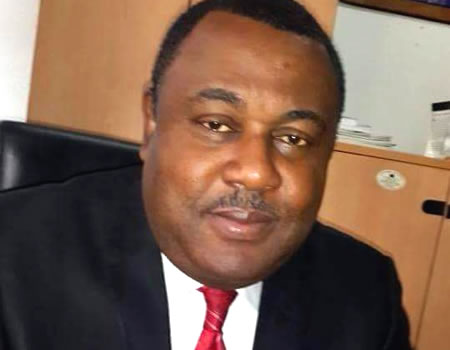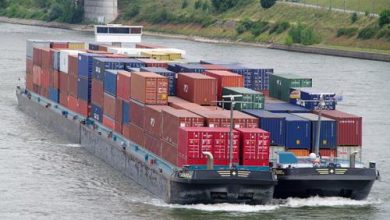Onitsha River Port: Many Lies of NIWA
 · Onitsha river channel isn’t charted, cargoes are uninsurable – Capt. Warredi
· Onitsha river channel isn’t charted, cargoes are uninsurable – Capt. Warredi
· Barge operators lament navigational troubles, security threats
· Why we choose roads over Onitsha river port – Freight Agents, Shippers
By Kenneth Jukpor
Amid the commendations for the National Inland Waterways Authority (NIWA) as it carried out a test run by moving empty containers to Onne Port from Onitsha River port recently, maritime experts have warned that the pertinent issues limiting the river port are yet to be addressed.
The barge operation utilized to move 16 empty containers in one voyage from the river port last week is being peddled as a mammoth political victory despite the numerous challenges reechoed by the barge operator who conveyed the containers.
There are also mysteries surrounding the concession framework for Onitsha river port with NIWA Managing Director, Dr. George Moghalu working assiduously to achieve this feat which was reportedly concluded under a previous NIWA leadership.
According to the NIWA Acting General Manager, Corporate Affairs, Mr. Jibril Darda’u, this trial showed that the perceived security and navigational challenges are surmountable.
“Everyone has seen that it is possible and it was successful. The NIWA Managing Director carried this test run in collaboration with the Boat Operators Association of Nigeria (BOAN). The President of BOAN, Mr. Kelikume Edeme actually volunteered the two barges that were utilized for this test run,” he told MMS Plus newspaper.
Meanwhile, shipping experts have lamented that the river channels aren’t charted and the waters prone to security challenges, shallow draft, ban on night movement on the waterways, among other challenges.
Speaking with MMS Plus on the viability of Onitsha river port last week, a former Director, Shipping Development at Nigerian Maritime Administration and Safety Agency (NIMASA), Capt. Warredi Enisuoh said the operation of the river port isn’t possible in its current state.
“In any business the first thing to consider is safety, but there is no safety of navigation to Onitsha river port. The channel to Onitsha is unmarked; hence, an insurance company would have to be stupid to insure such cargoes. What are the provisions for security? Would private security be hired to escort the ship or barge and is that arrangement constitutional? There is a restriction on night movement on the waterways which would affect such barge operations.”
“Let’s look at the duration for the journey. Lagos ports, Port Harcourt are far away, so a good example will be Forcados. The voyage from Forcados to Onitsha is about 400 nautical miles and moving cargoes by barges would see the journey double because of the Sun-set to Sun-rise curfew. The barge or vessel would do an average of 10 nautical miles per hour because the channel isn’t dredged and you can only move during the day. This means you can only travel 120 nautical miles in a day and the journey would take three to four days from Forcados to Onitsha. I’m being optimistic because 10 nautical miles per hour is very fast for an unmarked shallow channel. How many cargoes can the barges or ships carry to break even?” he queried.
Warredi also noted that bridges such as the Patani Bridge would limit vessels and barges during high tide, adding that river passage for ships requires speed limitations, which would have been provided if the river was charted.
On the concession arrangement, NIWA Spokesman, Jibril told MMS Plus that the Onitsha river port has attained 90 percent completion in the concession process, however, industry stakeholders and Nigerians remain in the dark about the bidders and eventual winner.
He said he couldn’t disclose the bidding process for the Onitsha river port, stating that such information should be disclosed by the Federal Ministry of Finance and the Infrastructure Concession Regulatory Commission (ICRC).
“The Finance Ministry and ICRC are responsible for the details of the concession while NIWA is more concerned about the commencement of operations. The NIWA Managing Director has reiterated that the concession process has reached 90 percent completion but technical aspects of this process aren’t open to the public” Jibril said.
While NIWA posits that the concession process is 90 percent complete, neither the agency, ICRC or the Finance Ministry has at any point announced a concessionaire or investor to manage the project.
Efforts to reach the Managing Director of ICRC, Mr. Chidi Izuwah to ascertain the level of progress on the Onitsha river port concession were futile until presstime on Friday, last week.
The NIWA Managing Director, Moghalu has reiterated the near complete concession framework; nevertheless, he also scheduled a meeting with technical partners from the Port of Antwerp which couldn’t hold as a result of travel restrictions following the outbreak of Coronavirus (COVID-19).
“There is a concession in process for Onitsha river port. But for the coronavirus outbreak, I should have left Nigeria with a team to visit the Port of Antwerp who are supposed to be the technical partners for the river port,” Moghalu said in March this year.
Maritime stakeholders and economic experts are perplexed at the fact that NIWA has been engaging technical partners for Onitsha river port; an arrangement which should have been part of the concessionaire’s bid for the project and the concessionaires/ investors ought to have been carrying out the engagements with technical partners.
On the containers moved from the Onitsha river port, Moghalu said, “the aim of the test run is to break the jinx and encourage partnership with the Barge Operators Association that is possible to move containers from Onne to Onitsha by water successfully and Onitsha to Onne as well”.
According to him, this is the first phase of the test run and the second phase will be from Lagos Ports to Onitsha River port and Onitsha to Lagos.
Describing the waterways as economically viable and safe, he encouraged investors to key in and benefits the potentials of water transportation, adding that the test run exercise was in preparation of the anticipated full operation of the port which will commence by first quarter of 2021.
While Moghalu preached safety and viability of the Onitsha river port, the barge operator who moved the empty containers, Mr. Kelikume Edeme said the test run trip was characterized by lots of security challenges and navigational impediments.
Edeme, who is also the President of BOAN, provided two barges for the test run, said, “We loaded eight 40ft and eight 20ft containers from Onitsha taking them to Onne port.”
“We encountered lots of security challenges as well as navigational challenges. The water needs to be dredged further to aid barge operations, but we can manage to continue doing it for now.”
Also speaking with MMS Plus, a veteran freight forwarder and shipper based in Rivers, Mr. Sam Epiah said, “When I read the news online that Maresk Line had concluded plans to move containers directly to Onitsha river port, I took it with a pinch of salt because I’m aware of the numerous challenges. However, Maersk Line has debunked those news reports.”
“Onitsha river port was developed to service traders and importers in the Eastern region and the port was made a destination port several years ago. The entire country is facing the challenge of security, however, the aspect of dredging is also a major impediment and that was why I didn’t believe the initial reports that Maersk Line would channel vessels to Onitsha. It isn’t easy to access the Onitsha river ports even with barges. It’s not as easy as it is painted on the pages of newspapers.”
Epiah, who is a member of the Board of Trustees (BOT) of Bayelsa and River States Shippers Association and Managing Director of Cloverleaf Shipping Limited, noted that Julius Berger Construction Company has been utilizing barges from Warri to Onitsha river port for project cargoes for the 2nd River Niger bridge.
He maintained that the success recorded by Julius Berger should be utilized as a marketing strategy to boost patronage by shippers, even as he stressed that barges shouldn’t be encouraged to move cargoes in the area without sufficient security.
“At the moment, the easiest way to get consignments to Onitsha remains trucking. We know that trucking isn’t a good alternative with the dilapidated state of the roads and multiple checkpoints. The next alternative is barges because vessels weren’t envisaged to go to Onitsha river port. The concept was that vessels would access Warri and Port Harcourt, subsequently; the containers would be loaded on barges and conveyed to Onitsha,” he added.
The Chairman, Nigerian Ports Consultative Council (PCC) Otunba Kunle Folarin also reechoed Epiah’s position, stating that the Onitsha river port and other river ports in the country weren’t conceived to receive vessels.
His words: “Onitsha river port development arose as a result of the government’s policy to facilitate distribution of cargoes from seaports. Between 2007 and 2012, River Niger was dredged to facilitate the transfer of cargoes destined for the Eastern part of Nigeria, especially for traders in Onitsha and the environs. The main objective was to facilitate Eastern cargoes from Lagos, Warri or Port Harcourt and this barging experience was to decongest the roads.”
Folarin, who was the chairman of the technical committee for the realization of river ports, noted that the move was also targeted to grow the enterprise in the various regions.
“It wasn’t Onitsha alone; there were also similar river port projects in Oguta, Lokoja, Makurdi, Baro. We travelled to over 100 destinations in seven littoral states during that project. This project had been hanging for several years but the then Acting Managing Director, Mrs. Chinwe Ezenwa put in efforts and as Chairman of the Committee, I also put in efforts to ensure the construction of these river ports.”
He recalled that the Onitsha river port had been commissioned in the 1980s; however, it lacked multi-modal transport connection.
“There must be an adequate road network to accommodate the traffic that the river ports would generate. When you transfer cargoes numbering thousands of containers, it is clear that the traffic situation and the road network would be stretched. It is very important that all the exits from Onitsha river port and others be dualized, so that we don’t solve one problem and create another,” he added.
At some point during high tides, the Onitsha river port which is described as a seasonal port could attain a depth of 13 meters which supports barge operations and flat bottom vessels; however, it could also get lower than 5 meters.
Consequently, it would be difficult to destine cargoes to Onitsha river port all year round under the current situation.
However, stakeholders posit that Nigeria could enforce the River Niger treaty to maintain the draft of the channels at a certain level and ensure coastal communities in the country and other nations don’t divert the water for irrigation and other factors that could limit the water levels.
The mismanagement of the River Niger has also been attributed as a factor grossly affecting Nigeria’s power supply as the flow of water is distorted by riverine communities and riparian states of the Niger River such as Niger, Benin, Chad, Guinea, Côte d’Ivoire, Mali, Nigeria, Cameroon and Burkina Faso.
However, there is a Niger Basin Authority (NBA) Convention, to promote cooperation among the Member States and to ensure an integrated development of the Niger Basin in the fields of energy, water resources, agriculture, animal husbandry, fishing and fisheries, forestry, transport, communications and industry.
More specifically, the Convention provides that the NBA is responsible for harmonizing and coordinating national development policies; assisting in the development of an integrated development plan for the Basin; promoting projects of common interest; assuring the regulation of navigation consistent with the 1963 Act; and requesting assistance and mobilizing financing for studies and research on Basin resources. The NBA is also tasked with maintaining contact with the Member States and keeping them informed of its work. Reciprocally, Member States pledged to inform the Executive Secretary of the NBA of projects they propose to carry out in the Basin.
In 2008, at the Eight Heads of State and Government Summit, West African Heads of State of the Niger Basin riparian countries adopted a twenty year, 5.5 billion euro program to reforest, rehabilitate and remove silt from the Niger River. Some eighty percent of the funding is to be earmarked for developing social and economic infrastructure, with a smaller amount to protect natural resources and ecosystems. The plan is to be implemented in four five-year phases.
The 2008 Summit also resulted in the adoption of a “Water Charter” designed to ensure that NBA Member States share the river’s resources fairly and responsibly. The Charter lays out a series of general principles for equitable and reasonable participation and use of Niger River water, obligating parties not to cause harm to other states in accordance with the Convention; to take certain precautionary, preventive and corrective measures; to take into account a polluter-pays principle, such that costs of pollution are borne by the polluters (whether legal persons or individuals); and to take into account an off-taker-pays principle to include the setting of water tariffs depending on use.
The Water Charter also contains several general obligations, including for parties to manage the Niger Basin water to preserve and protect the environment, and to institute policing measures; but Nigeria doesn’t have any agency saddled with the responsibility to monitor the River Niger.
Capt. Warredi suggested that Nigeria could build locks at the depths of the River Niger to ensure that at certain locations the water doesn’t fall below a certain level or rise above a given level to aid navigation along the channel.
He also added that there are investors ready to carry out these activities if the Nigerian government genuinely approaches such multinational firms.








These are personal opinions are selfish positions of individuals who aren’t interested in the development of the inland water and coastal transpose system in Nigeria.
How can a so called professional make public assertion that the Onitsha port wasn’t conceived to receive vessels when in reality, vessel navigation from the port up north to Lokaja and Bark was a normal practice in the colonial and precolonial era. What then was the port conceived to do?
Security challenges cannot be enough reason to abandon navigation via the water route as such security challenges are surmountable. Infact, it will take a serious government nothing to put in place a serious maritime security architecture to handle all such challenges.
The attention should be on charting the channel and dredging it to safely accommodate vessels.
People should stop distracting the NIWA boss and give him the necessary support to develop the sector.
Onitsha River Port is a viable project but there are lots of challenges yet to be addressed.
NIWA would have to address these issues to record any success with Onitsha River Port.
The challenges in this write-up were itemized by the barge operator who carried out the test run.
After a survey and report carried out by a veteran ship captain and former Director of Shipping Development @NIMASA, he’s equally well placed to proffer advice that NIWA should value.
The concerns of freight forwarders and shippers in the area are real, and also highlighted in this piece.
Dear Theo, these contributions should guide NIWA aright and you should give the contributors credit.